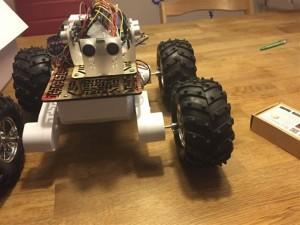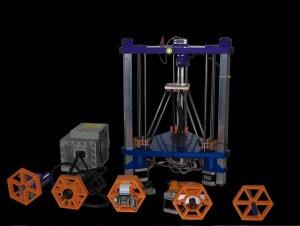/ News

3D Printing: The Stories We Didn’t Cover This Week — March 1, 2015
This week’s stories we didn’t cover include technical 3D printing projects, including a bird-like drone and an autonomous robotic car, a Kickstarter campaign for a Tennessee-based 3d printed toy company, and a Smithsonian exhibit on human tools that includes the International Space Station’s 3D printer along with some of the objects it has printed. Back on earth a British company offers the ability to 3D print your flow metrics from your own website data to create an unusual landscape figure. Finally, two new 3D printers have emerged on the printing scene: one is an impressive mini-factory made by the open source duo Diyourself, and the other is a (tongue in cheek) prototype of an Everything-Bot made by the 4 year old daughter of Julian Sing, engineer and 3D printing chef extraordinaire. This just goes to show you there’s something for everyone’s imagination when it comes to the future of 3D printing.
Chattanooga’s “G0 Time” Launches Kickstarter Campaign

In an effort to get our 3D printing gears churning, Chattanooga, Tennessee has become a bit of a 3D printing hub with public access to 3D printers through the local university and public library. One of the many projects emerging from this new hub of activity is “Go Time” — a company that began making car toys that people could print and race themselves. Now the company has evolved into making educational and fun gear-style connecting toys; they are brightly colored, 3D printed gears — “mechanical block sets comprised of interlocking frame parts, gears, and axle bits.” The company has now launched a Kickstarter campaign that ends on March 16th. It is hoping to raise $30,000 to fund its purchase of an injection mold so Go Time can continue making great gear toys for kids of all ages. If you are into mechanical and connecting block set toys, or know someone who is, you may want to support the company’s latest fundraising project.
Smithsonian Exhibit Features Space Station Printer

Trade shows are one of the more common places to check out what’s new with 3D printing, but occasionally you may also see a 3D printer on display in a museum as well. In order to illustrate how tools have changed over a span of 1.85 million years, New York City’s Smithsonian Design Museum is hosting an exhibit “Tools: Extending our Reach” with the goal of showing various ways tools are used throughout human history. The 3D printer that accompanied astronauts on the International Space Station (ISS)– the Zero G Printer — is currently being used there to print objects, and the printer (along with some of its objects) is included in the exhibit. The whole idea of this “flying factory” is a partnership between NASA and Made in Space to show how 3D printing can aid space exploration by supporting the ability to make things in space — instead of having to pack everything in. It’s no surprise that this “flying factory” is of great interest to those considering how 3D printing is a versatile tool, whether we are staying Earth-bound or heading to outer space.
3D Printed Bird-Like Drone

Speaking of things that fly, a University of Maryland research team has reported significant improvements in its 3D printed Robo Raven drone project that mimics the motions of an actual bird in flight. Reported in the journal, Soft Robotics, the researchers have been seeking a drone with wings that operate more like a bird’s wings and move independently. “Flapping Wing Air Vehicles” (FWAV’s) are usually operated with a single actuator that controls both wings, but the success of Robo Raven largely depends on the fact that each wing can move independently. As the researchers state, there is still much work to do in order to have the wings emulate a bird’s completely, but the ability for a drone to complete more complicated flight patterns has been achieved.
3D Printed Dagu Rover Robot

Closer to the ground than the Robo Raven is the the Dagu Electronics Rover 5, which is a popular design for a 3D printed robot car. And “theophil” has taken this Rover design one step further by making it an autonomous robot. It has two built-in DC motors (and two more motors) that move the car by remote control. Using a Printrbot Simple Metal 3D printer, components were printed to mount the motors and other parts on — these parts include a 6-AA battery holder, an Arduino Mega, 3 SRO4 sonic sensors, a magnetometer, a gyro, and a Pololu MinIMU 9 compass. Theophil, a computer scientist, also handles the software portion of the design by using ArduinoPID library to control all four motors so wheels move together at the right speed. It’s still very much a design in progress, but you can check out his impressive progress so far here.
3D Print Your Website’s DNA

Britain-based company, Majestic, runs the planet’s largest link index database, and it has a great idea for all of the unique data generated by your website’s links and relationships with other sites on the Internet. It has taken it and shaped it into 3D printed landscapes. These landscapes are statuettes made from “flow metrics” , which is a complex system for capturing the traffic your website generates (that’s Google’s landscape to the right.) Every website is different and features different link profiles, so no two 3D printed landscapes are the same. These landscapes stand as trophies or souvenirs of your website’s own link profile progress, and Majestic has made the 3D software available if you sign up to receive its occasional announcements, which you can subscribe to here.
Open Source Twin Teeth Mini-Factory is Developed by Diyouware

Two brothers who comprise Diyouware have released their design for a “Twin Teeth” multi-purpose PCB manufacturing machine that gets its name from the principle of moving the construction bed instead of the tool head. This allows for interchangeable heads involved in all aspects of the fabrication process. This mini-factory can perform many functions including: photoengrave with a UV laser on sensitive film or pre-sensitized boards; drill holes using any mini-rotary tool; dispense solder paste onto SMD PCB pads; plot circuits with a permanent pen-maker; 3D print knobs, casings, and front-panels; print circuits with conductive filament, or make circuits supports; and mill or carve soft materials. Since the Twin Teeth can accommodate many different kinds of tool heads, it has unlimited potential with its only real limit being its small Arduino shield sized work space.
4 Year Old Develops Own Everything-Bot Prototype

Since this week’s news has included so much technical talk, we end our stories we didn’t cover this week on a light-hearted note as we see 3D printing chef, Julian Sing, help his four year old daughter realize her vision of an “Everything-Bot” printer with a built-in sensor that can read any object and make it! You are never too young to come up with your next big thing in 3D printing, as Sing’s own daughter’s prototype reminds us.
And those are all the stories we didn’t cover this week.

Source: http://3dprint.com/47864/3d-printing-the-stories/
/ About us
Founded by Russian entrepreneur Dmitry Itskov in February 2011 with the participation of leading Russian specialists in the field of neural interfaces, robotics, artificial organs and systems.
The main goals of the 2045 Initiative: the creation and realization of a new strategy for the development of humanity which meets global civilization challenges; the creation of optimale conditions promoting the spiritual enlightenment of humanity; and the realization of a new futuristic reality based on 5 principles: high spirituality, high culture, high ethics, high science and high technologies.
The main science mega-project of the 2045 Initiative aims to create technologies enabling the transfer of a individual’s personality to a more advanced non-biological carrier, and extending life, including to the point of immortality. We devote particular attention to enabling the fullest possible dialogue between the world’s major spiritual traditions, science and society.
A large-scale transformation of humanity, comparable to some of the major spiritual and sci-tech revolutions in history, will require a new strategy. We believe this to be necessary to overcome existing crises, which threaten our planetary habitat and the continued existence of humanity as a species. With the 2045 Initiative, we hope to realize a new strategy for humanity's development, and in so doing, create a more productive, fulfilling, and satisfying future.
The "2045" team is working towards creating an international research center where leading scientists will be engaged in research and development in the fields of anthropomorphic robotics, living systems modeling and brain and consciousness modeling with the goal of transferring one’s individual consciousness to an artificial carrier and achieving cybernetic immortality.
An annual congress "The Global Future 2045" is organized by the Initiative to give platform for discussing mankind's evolutionary strategy based on technologies of cybernetic immortality as well as the possible impact of such technologies on global society, politics and economies of the future.
Future prospects of "2045" Initiative for society
2015-2020
The emergence and widespread use of affordable android "avatars" controlled by a "brain-computer" interface. Coupled with related technologies “avatars’ will give people a number of new features: ability to work in dangerous environments, perform rescue operations, travel in extreme situations etc.
Avatar components will be used in medicine for the rehabilitation of fully or partially disabled patients giving them prosthetic limbs or recover lost senses.
2020-2025
Creation of an autonomous life-support system for the human brain linked to a robot, ‘avatar’, will save people whose body is completely worn out or irreversibly damaged. Any patient with an intact brain will be able to return to a fully functioning bodily life. Such technologies will greatly enlarge the possibility of hybrid bio-electronic devices, thus creating a new IT revolution and will make all kinds of superimpositions of electronic and biological systems possible.
2030-2035
Creation of a computer model of the brain and human consciousness with the subsequent development of means to transfer individual consciousness onto an artificial carrier. This development will profoundly change the world, it will not only give everyone the possibility of cybernetic immortality but will also create a friendly artificial intelligence, expand human capabilities and provide opportunities for ordinary people to restore or modify their own brain multiple times. The final result at this stage can be a real revolution in the understanding of human nature that will completely change the human and technical prospects for humanity.
2045
This is the time when substance-independent minds will receive new bodies with capacities far exceeding those of ordinary humans. A new era for humanity will arrive! Changes will occur in all spheres of human activity – energy generation, transportation, politics, medicine, psychology, sciences, and so on.
Today it is hard to imagine a future when bodies consisting of nanorobots will become affordable and capable of taking any form. It is also hard to imagine body holograms featuring controlled matter. One thing is clear however: humanity, for the first time in its history, will make a fully managed evolutionary transition and eventually become a new species. Moreover, prerequisites for a large-scale expansion into outer space will be created as well.
Key elements of the project in the future
• International social movement
• social network immortal.me
• charitable foundation "Global Future 2045" (Foundation 2045)
• scientific research centre "Immortality"
• business incubator
• University of "Immortality"
• annual award for contribution to the realization of the project of "Immortality”.



 LinkedIn
LinkedIn
 LiveJournal
LiveJournal
 Google
Google
 Twitter
Twitter
 Facebook
Facebook
 Я.ру
Я.ру
 ВКонтакте
ВКонтакте
 Mail.ru
Mail.ru